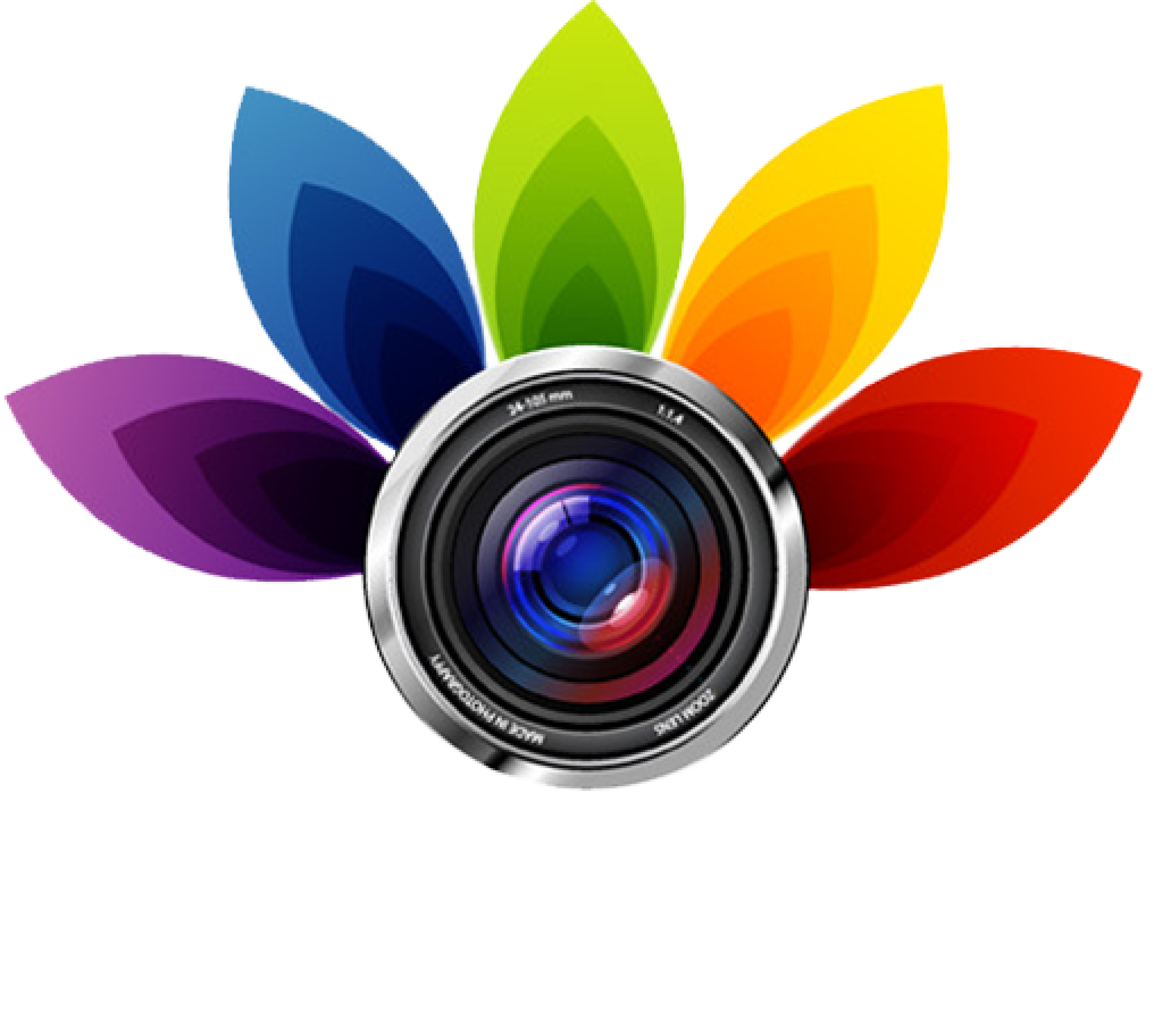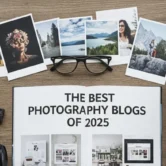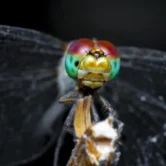
How to Spot the Difference Between AI and Manual Photo Edits
Difference Between AI and Manual photo edits is something many people wonder about, especially with editing tools getting smarter every day. AI makes it quick and simple to fix photos, while manual editing relies on a person’s eye and skill. Both styles can create amazing results, but the look and feel are often not the same. Some edits appear too perfect or uniform, while others show careful detail and creativity. Understanding these differences helps you decide which type of editing fits your photos best.
The difference between AI and manual edits goes beyond just speed. AI can process thousands of photos fast, but it sometimes misses the natural touch. Manual edits may take longer, yet they allow for more control and personal style. Each method is used in different fields depending on what the client or project requires. By learning how to tell them apart, you’ll be able to spot if a photo was edited by a machine or by hand. This can also guide you when choosing the right service or tool for your needs.
Why the Difference Between AI and Manual Photo Edits Matters
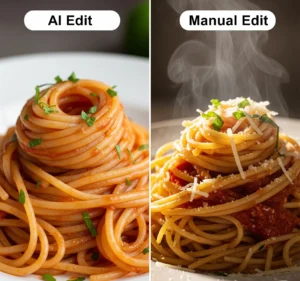 The difference between AI and manual photo edits matters because each one shapes the final look of your photos in very different ways. AI editing is all about speed and consistency, making it useful for handling big batches of images without much effort. However, while it’s quick, it sometimes produces results that look too uniform or artificial. Manual editing, on the other hand, focuses on detail and creativity, giving photos a more natural and polished appearance. Knowing how each works helps you choose the right method depending on the project.
The difference between AI and manual photo edits matters because each one shapes the final look of your photos in very different ways. AI editing is all about speed and consistency, making it useful for handling big batches of images without much effort. However, while it’s quick, it sometimes produces results that look too uniform or artificial. Manual editing, on the other hand, focuses on detail and creativity, giving photos a more natural and polished appearance. Knowing how each works helps you choose the right method depending on the project.
Understanding this difference is also important when considering quality and purpose. For professional photos, like portraits or marketing visuals, manual editing often brings better results because it adds personality and precision. For large-scale needs, like eCommerce product images, AI can save time while still delivering good results. Many editors even use a mix of both, AI for basic edits and manual work for final touches. By recognizing their differences, you can make smarter decisions that fit your goals.
Tips for readers:
- Use AI when you need quick and consistent edits across many photos.
- Choose manual editing for detailed projects that need a creative or natural look.
- Consider mixing both methods for balance between speed and quality.
- Think about the purpose of your photos before deciding which method works best.
Speed vs Skill in Modern Editing
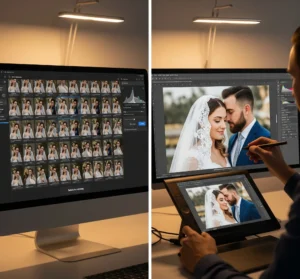 AI photo editing is designed to work fast, handling large batches of images in just a few minutes. This makes it helpful for projects that require quick turnaround, like eCommerce product listings or event photos with tight deadlines. The speed of AI comes from its ability to follow preset instructions and apply changes consistently across many images. However, while it saves time, it may sometimes miss small details or fail to handle complex adjustments that require human judgment.
AI photo editing is designed to work fast, handling large batches of images in just a few minutes. This makes it helpful for projects that require quick turnaround, like eCommerce product listings or event photos with tight deadlines. The speed of AI comes from its ability to follow preset instructions and apply changes consistently across many images. However, while it saves time, it may sometimes miss small details or fail to handle complex adjustments that require human judgment.
On the other hand, manual editing focuses more on skill and precision. A trained editor can carefully adjust tones, remove distractions, and highlight details that AI might overlook. Manual work often results in a more polished and natural look because it relies on human creativity and experience. The process is slower, but it’s more flexible and allows for personal touches that match a client’s unique style. For those deciding between the two, the choice often depends on the type of project and the level of quality needed.
Tips to consider:
- Use AI editing for bulk images or when you need quick results.
- Choose manual editing for projects that require high detail and creative adjustments.
- A mix of both can give you speed and quality at the same time.
- Always review AI-edited images to make sure that they meet your standards.
How AI and Manual Editing Will Shape the Future
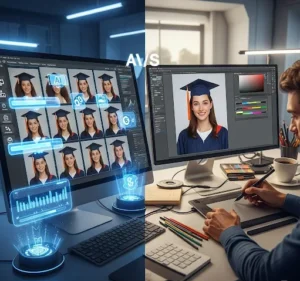 AI editing often focuses on consistency and speed, which can make the style look uniform across many images. This works well when you need the same look for a large set, such as product catalogs or bulk event photos. However, this uniform style sometimes lacks depth or creativity because AI follows pre-set patterns. Details like soft skin tones, shadows, or artistic effects may not always be handled with the same care as a skilled human editor. Manual editing, on the other hand, allows for more control over style and finer details.
AI editing often focuses on consistency and speed, which can make the style look uniform across many images. This works well when you need the same look for a large set, such as product catalogs or bulk event photos. However, this uniform style sometimes lacks depth or creativity because AI follows pre-set patterns. Details like soft skin tones, shadows, or artistic effects may not always be handled with the same care as a skilled human editor. Manual editing, on the other hand, allows for more control over style and finer details.
Editors can adjust every part of the photo based on how it should look, making it more personal and artistic. This approach makes sure that editors carefully refine small details, such as natural lighting or texture. While it takes longer, the results often carry more character and individuality. The difference lies in how AI focuses on efficiency, while manual editing highlights the human touch.
Tips for readers:
- Use AI when consistency across many images is more important than creative style.
- Choose manual editing when the photo needs artistic detail and a personal finish.
- Think about your project goal, speed or style before deciding which to use.
- For best results, combine AI for base edits and manual work for final touches.
Signs to Spot the Difference Between AI and Manual Edits
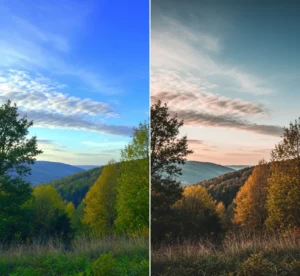 AI edits often leave signs of speed but sometimes miss natural details. For example, skin may look too smooth, colors might appear slightly flat, or objects may be cut out with rough edges. AI also tends to apply the same adjustments across all photos, which can make images look repetitive. These are common indicators that an edit was done quickly by a program rather than carefully by hand.
AI edits often leave signs of speed but sometimes miss natural details. For example, skin may look too smooth, colors might appear slightly flat, or objects may be cut out with rough edges. AI also tends to apply the same adjustments across all photos, which can make images look repetitive. These are common indicators that an edit was done quickly by a program rather than carefully by hand.
Manual edits usually have a more natural and balanced look because they are done with care and attention. You’ll notice that shadows, highlights, and textures are adjusted smoothly, without looking too artificial. Manual work often shows creativity in how colors are blended and how details are highlighted. Each photo may look slightly different because it was edited with personal judgment instead of automated rules.
Tips for spotting the difference:
- Look at skin texture – AI often makes it too perfect or plastic-looking.
- Check object edges – AI may leave halos or uneven cutouts.
- Notice consistency – AI edits may look identical across many photos.
- See if details feel natural – manual edits usually keep depth and balance.
When to Choose AI or Manual
 AI editing is a great choice when you need results quickly or have a large number of photos to process. It works well for simple tasks like background removal, color correction, or resizing. If the project is time-sensitive, such as ecommerce listings or event photos you need to upload quickly, AI can save you a lot of effort. The trade-off is that while it’s fast, it may not always provide the best detail or creativity. Manual editing is best when you need quality, creativity, and attention to small details. It’s ideal for projects like portraits or jewelries where every image needs to stand out.
AI editing is a great choice when you need results quickly or have a large number of photos to process. It works well for simple tasks like background removal, color correction, or resizing. If the project is time-sensitive, such as ecommerce listings or event photos you need to upload quickly, AI can save you a lot of effort. The trade-off is that while it’s fast, it may not always provide the best detail or creativity. Manual editing is best when you need quality, creativity, and attention to small details. It’s ideal for projects like portraits or jewelries where every image needs to stand out.
A skilled editor can adjust lighting, remove distractions, and give a natural and artistic finish that AI cannot fully achieve. Though it takes more time, manual editing makes sure that each photo has a unique and professional look.
Tips to decide wisely:
- Choose AI for bulk tasks and simple edits with fast turnaround.
- Go with manual editing for detailed projects that need creativity and precision.
- Use both together; AI for basic edits and manual for final polishing.
- Consider your budget, timeline, and quality standards before making a choice.
How AI and Manual Editing Will Shape the Future
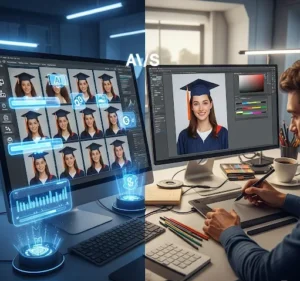 The future of photo editing will likely blend both AI and manual methods, instead of one replacing the other. AI will continue to improve in speed, accuracy, and even creative suggestions, making it an even stronger tool for handling large amounts of work. This will help businesses and individuals save time while maintaining consistent results. Still, AI will always have limits because it relies on programmed rules and may not fully match human creativity. Manual editing, meanwhile, will remain valuable for projects that need personality, emotion, and artistic depth.
The future of photo editing will likely blend both AI and manual methods, instead of one replacing the other. AI will continue to improve in speed, accuracy, and even creative suggestions, making it an even stronger tool for handling large amounts of work. This will help businesses and individuals save time while maintaining consistent results. Still, AI will always have limits because it relies on programmed rules and may not fully match human creativity. Manual editing, meanwhile, will remain valuable for projects that need personality, emotion, and artistic depth.
Skilled editors will use their judgment and creativity to bring out the best in photos, something AI cannot fully copy. In the future, editors may rely on AI for basic tasks but still add their own touch for finishing details. This teamwork between technology and human skill is where the future of editing is heading.
What to expect in the future:
- Faster AI tools with more advanced features.
- Manual editing focused on creativity and artistic quality.
- A growing trend of combining AI speed with human finishing touches.
- Higher demand for editors who can work alongside AI effectively.
Conclusion
The difference between AI and manual photo editing shows us that both have unique strengths, and the best choice depends on what you need. AI gives you speed and efficiency, while manual editing provides creativity and fine detail that a machine can’t fully match. In the future, we’ll likely see both working together to balance quick results with a personal touch. What matters most is knowing when to use one, the other, or a mix of both. Now, I’d love to hear your thoughts, do you prefer the fast results of AI or the artistic detail of manual editing? Share your opinion in the comments below!
Read Next: How to Make Attractive AI Product Photos for Ecommerce Shops
